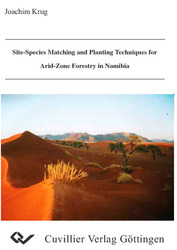| Departments | |
|---|---|
| Book Series (96) |
1378
|
| Nachhaltigkeit |
3
|
| Gesundheitswesen |
1
|
| Humanities |
2363
|
| Natural Sciences |
5406
|
| Mathematics | 229 |
| Informatics | 319 |
| Physics | 980 |
| Chemistry | 1363 |
| Geosciences | 131 |
| Human medicine | 243 |
| Stomatology | 10 |
| Veterinary medicine | 108 |
| Pharmacy | 147 |
| Biology | 835 |
| Biochemistry, molecular biology, gene technology | 121 |
| Biophysics | 25 |
| Domestic and nutritional science | 45 |
| Agricultural science | 1004 |
| Forest science | 201 |
| Horticultural science | 20 |
| Environmental research, ecology and landscape conservation | 148 |
| Engineering |
1791
|
| Common |
98
|
|
Leitlinien Unfallchirurgie
5. Auflage bestellen |
|
Advanced Search
Site species matching and planting techniques for arid-zone forestry in Namibia (English shop)
Joachim Krug (Author)Preview
Table of Contents, Datei (88 KB)
Extract, Datei (140 KB)
This thesis takes the edaphic water conditions and the soil-salinity as the most constraining factors for the growth of trees, ranging from the Namib Desert up to the dry deciduous forests in the Caprivi Region. In the line of the potential concept, the move-ment of water between atmosphere, plant and soil is understood as a process driven by potential gradients, hence by potential energy. This energy-releasing process is persis-tent until the potentials are in a status of equilibrium. The potentials considered to be of effective importance for the approach of this thesis are reflected by the water potential and osmotic potential. To evaluate these factors independently, the actual, tree-effective soil water budget is reflected on the natural stand by the plant water potential at pre-dawn (assessed with a Scholander pressure chamber). The salinity of the rhizosphere is echoed by the standardised plant osmotic potential to describe the soil-osmotic situation affecting the recorded trees, by the determination of the freezing point depression of leave sap (cryoscopic measurement). On the other hand, the range of the trees’ level and ability of adaptation towards these limiting factors is described by the plant water poten-tial at midday which the investigated species is able to build up under the most arid conditions – that is, at the end of the dry season. Parallel to that, the plant osmotic po-tential as well assessed under the least favourable conditions (at midday and at the end of the dry season) reflects the current pessimum near osmotic situation for the plant. These physiological parameters were completed with structural, morphological data to evaluate the locations with respected site factors.
| ISBN-13 (Printausgabe) | 3865373216 |
| ISBN-13 (Hard Copy) | 9783865373212 |
| ISBN-13 (eBook) | 9783736913219 |
| Final Book Format | A5 |
| Language | German |
| Page Number | 190 |
| Edition | 1 Aufl. |
| Volume | 0 |
| Publication Place | Göttingen |
| Place of Dissertation | Göttingen |
| Publication Date | 2005-01-04 |
| General Categorization | Dissertation |
| Departments |
Forest science
|








